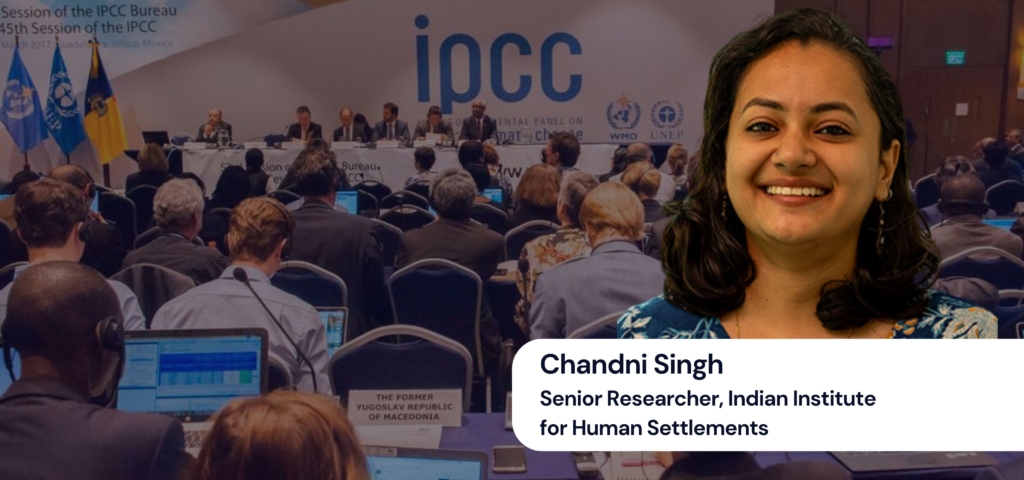The recent IPCC report has left no room for doubt: climate change impacts every facet of our world, and India is no exception. From the economy to ecosystems, climate risks cast a long shadow over our future. The report underscores the urgency of addressing these challenges, but it also highlights the importance of holistic, long-term solutions. In this blog post, we explore key takeaways from the conversation between Shreya Jai and Chandni Singh, two experts discussing climate adaptation efforts in India and the concept of maladaptation.

Understanding the Current State of Climate Adaptation
Chandni Singh emphasizes the current state of climate adaptation efforts, describing them as fragmented, small-scale, and often reactive. These efforts are sector-specific and focus on immediate responses to current impacts. While this approach can help manage specific risks, it often falls short in terms of long-term resilience.
One key constraint is the lack of transformational adaptation – strategies that fundamentally change the way systems function. Such transformation is essential to tackle compounding risks and impacts effectively. While adaptation planning is widespread, implementation remains a significant challenge, creating an adaptation gap that urgently needs to be closed.
India’s Unique Challenges
India’s climate adaptation landscape is complex. While the nation has established national and state action plans on climate change, these documents primarily emphasize mitigation over adaptation. Moreover, they tend to focus on visible disasters like flooding and droughts, neglecting emerging threats like extreme heat and changing disease patterns.
Another critical gap is the recognition that climate impacts do not affect everyone equally. Vulnerable groups based on factors such as gender, caste, income, and livelihood are often left out of adaptation strategies. Policymakers must adopt more nuanced, inclusive approaches to address these disparities.
Institutional and policy constraints further complicate the adaptation process. Short-term, reactive planning remains the norm, while forward-looking, long-term planning is insufficient. Singh cites the example of Bangladesh’s Delta Plan, which spans a hundred years, as a model for long-term thinking. Capacity building is another significant challenge, although there is evidence that development priorities and adaptation can be integrated successfully.
Maladaptation: Unintended Consequences of Adaptation
The concept of maladaptation is a central concern. Maladaptation refers to the unintentional negative consequences of adaptation efforts. Despite good intentions, these initiatives can increase risks, harm ecosystems, and even lead to higher greenhouse gas emissions. In the context of India, there are examples of maladaptation that illustrate these challenges.
One example is the construction of sea walls to address coastal flooding. While sea walls protect against rising sea levels, they can disrupt local ecosystems and harm livelihoods dependent on fishing. This illustrates how well-intended adaptation measures can lead to unintended negative outcomes.
Another example is the promotion of farm ponds to provide protective irrigation. While this initiative increased agricultural yields in the short term, it also led to the over-extraction of groundwater, worsening water scarcity for vulnerable groups. These cases highlight the importance of considering long-term consequences and ripple effects when planning adaptation strategies.
Balancing Development and Climate Resilience
India’s geographic vulnerability to climate change is compounded by its ambitious development goals. To strike a balance, Singh proposes the concept of climate-resilient development. This approach entails mapping out feasible adaptation options and assessing their synergies with mitigation and sustainable development goals.
Feasible adaptation options include early warning systems and urban green infrastructure, which have demonstrated potential to address climate risks. However, barriers such as governance issues, social acceptability, and financial constraints must be overcome to implement these solutions effectively.
One key takeaway is the need for a proactive shift toward nature-based solutions that transcend sectoral boundaries. These solutions can simultaneously enhance resilience, mitigate climate change, and contribute to sustainable development. Moreover, Singh highlights the role of education and behavioral change as essential tools to mobilize society toward climate action.
Conclusion
India stands at a crossroads, facing the dual challenges of development and climate change. Climate adaptation efforts must transition from fragmented, reactive measures to holistic, transformative strategies. Inclusive policies that address vulnerabilities and recognize the diverse impacts of climate change are vital. The concept of maladaptation serves as a stark reminder of the importance of long-term thinking and comprehensive planning.
Balancing development and climate resilience requires climate-resilient development strategies that consider the feasibility of adaptation options, their synergies with mitigation, and their alignment with sustainable development goals. By prioritizing nature-based solutions and fostering climate literacy and behavioral change, India can navigate these challenges and build a more resilient future.
(Access the complete interview by tuning in to the TIEH podcast available on our website and other major podcast platforms.)


